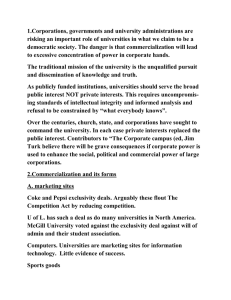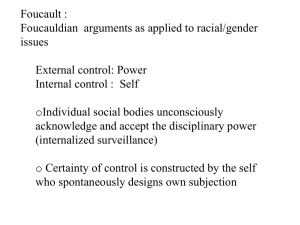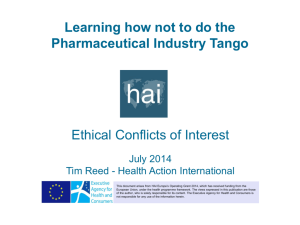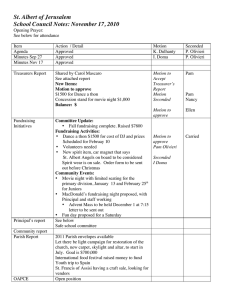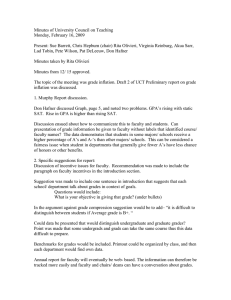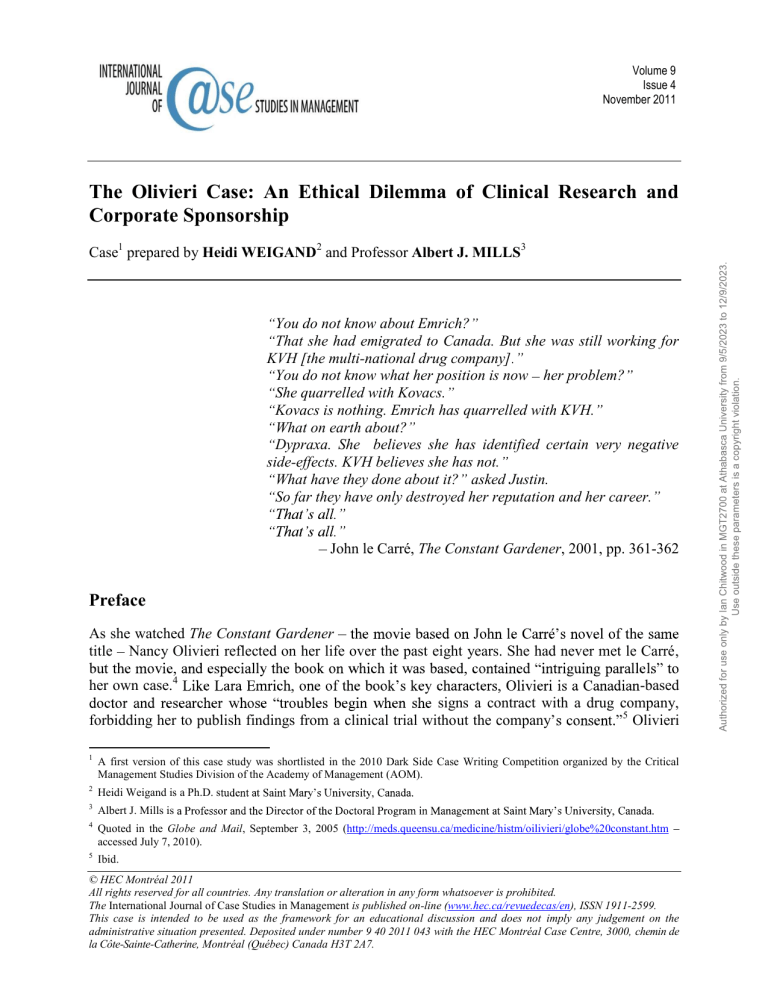
Volume 9 Issue 4 November 2011 The Olivieri Case: An Ethical Dilemma of Clinical Research and Corporate Sponsorship Case1 prepared by Heidi WEIGAND2 and Professor Albert J. MILLS3 You do not know about Emrich? That she had emigrated to Canada. But she was still working for KVH [the multi-national drug company] You do not know what her position is now her problem? She quarrelled with Kovacs. Kovacs is nothing. Emrich has quarrelled with KVH. What on earth about? Dypraxa. She believes she has identified certain very negative side-effects. KVH believes she has not. What have they done about it? asked Justin. So far they have only destroyed her reputation and her career. John le Carré, The Constant Gardener, 2001, pp. 361-362 Preface As she watched The Constant Gardener title Nancy Olivieri reflected on her life over the past eight years. She had never met le Carré, her own case.4 -based signs a contract with a drug company, 5 forbidding her to publish findings from a clinical trial without the company Olivieri 1 A first version of this case study was shortlisted in the 2010 Dark Side Case Writing Competition organized by the Critical Management Studies Division of the Academy of Management (AOM). 2 Heidi Weigand is a Ph.D. s 3 Albert J. Mills is 4 Quoted in the Globe and Mail, September 3, 2005 (http://meds.queensu.ca/medicine/histm/oilivieri/globe%20constant.htm accessed July 7, 2010). 5 Ibid. © HEC Montréal 2011 All rights reserved for all countries. Any translation or alteration in any form whatsoever is prohibited. The International Journal of Case Studies in Management is published on-line (www.hec.ca/revuedecas/en), ISSN 1911-2599. This case is intended to be used as the framework for an educational discussion and does not imply any judgement on the administrative situation presented. Deposited under number 9 40 2011 043 with the HEC Montréal Case Centre, 3000, chemin de la Côte-Sainte-Catherine, Montréal (Québec) Canada H3T 2A7. The Olivieri Case: An Ethical Dilemma of Clinical Research and Corporate Sponsorship Hospital for Sick Children]. Like me, Lara studied a drug to be prescribed in poorer countries and, when she sought to disclose her subsequent concerns about the drug, was met with vigorous 1 and dangerous side-effects of the drug she was administering. 2 3 Vindicated by the Ontario College of Physicians, the Canadian Association of University Teachers (CAUT) and other independent bodies, Olivieri would nonetheless continue to be vilified by some in the medical profession and sections of the media.4 Applauding exploitation of vulnerable patients in medical research conducted by certain drug companies, 5 Olivieri could not be blamed for pondering the very difficult and ethically problematic road she had travelled to this point. Nonetheless, as the case will show, there are still debates around her approach to the ethics of the case.6 Introduction For Nancy Olivieri, The Constant Gardener realistic account of the situation that individuals can find themselves in when confronting c 1989 when Dr. Nancy Olivieri became involved in an initial pilot study of an experimental drug developed to deal with a potentially fatal blood disorder called thalassemia. Initial promising results at the Hospital for Sick Children (HSC) in Toronto encouraged Olivieri to seek funding to 1 Ibid. 2 Ibid. 3 Ibid. 4 In 2005, (Shuchman, 2005, cited in Brody, 2007, http://brodyhooked.blogspot.com/2007/02/olivieri-case-she-said-they-said.html accessed July 7, 2010). Brody (2006), who included his own account of the case in his book on ethics and the medical profession later recanted some of his support for Olivieri. He now argues that, based on his reading of the Shuchman (2005) book, truth about this case. The people in a position to tell investigators what really happened and when, have divided themselves into pro- and anti-Olivieri camps; and depending on which side any new investigator appears to be on, one group will talk with her and the other will refuse to be interviewed. My tentative conclusion is that while the CAUT report is very well documented and persuasive on its face, any account of the Olivieri case based on that report will have to have an asterisk next to it, like the home (http://brodyhooked.blogspot.com/2007/02/olivieri-case-she-saidthey-said.html accessed July 7, 2010). 5 Olivieri, quoted in the Globe and Mail, September 3, 2005. 6 Shuchman (2005) suggests that, at least in this c issues (cited by Brody, 2007). Schafer (2007), on the other hand, argues: those who have the temerity to challenge powerful vested interests. In the popular imagination David bravely slays Goliath. Alas, in the real world, the whistle-described as an act of private disloyalty and, worse, as evidence of professional incompetence and psychological disturbance (http://brodyhooked.blogspot.com/2007/02/olivieri-caseshe-said-they-said.html accessed July 7, 2010). © HEC Montréal 2 The Olivieri Case: An Ethical Dilemma of Clinical Research and Corporate Sponsorship continue research on the drug. An extension of the clinical drug trials was supported by Apotex Inc., a private pharmaceutical manufacturer, director for clinical research, Dr. Gideon Koren, signed a contract with Apotex. The contract included confidentiality, communication and intellectual rights clauses and the level of profits that would accrue to the company in exchange for continued funding for the clinical trials. The unexpected effects of the trial drug (Deferiprone) ultimately changed the direction of this story. e., it had poisonous effects on some patients) nature cases).1 In other words, the drug appeared to increase others ceased to be effective after a period of time. Problems arose when Olivieri set out to report her findings to the u Board (REB) and to inform her patients i.e., the parents of the sick children involved 2 of the Under contractual obligations to Apotex, Olivieri began by trying to convince the company of her need to report her adverse findings. Apotex disagreed with her findings and her request to notify the REB, placing Olivieri in an ethical dilemma of honouring either her contractual obligations to Apotex or her broader commitment to uphold the ethics of medical practice in general and those of the REB in particular. She chose the latter and ended up embroiled in a series of disputes in which she found herself confronted by legal challenges from Apotex, institutional pressures from the University of Toronto and the HSC and attacks on her character from various people, including her colleague Dr. Gideon Koren. To Dypraxa was her Deferiprone. But fiction merged with fact when Olivieri found her reputation as a scientist, a researcher and a person was attacked on all fronts. In the novel, under severe pressures, Lara Emrich chose to run away from the issues involved. Nancy Olivieri chose to make a stand. The case, as we shall show, raises important questions about ethics at work and issues of the contexts in which organizational members attempt to make decisions. Knowing some of the key facts of the case, one wonders whether Olivieri would do it again if she had to. The case highlights the ethical dilemmas involved and asks students to consider how they would respond if placed in a similar situation. 1 http://en.wikipedia.org/wiki/Nancy_Fern_Olivieri. 2 Note that, in Canada, all research involving human subjects must be pre-approved by a u changes in the process must be reported to the REB (see Bryman, Bell, Mills and Yue, 2011). © HEC Montréal 3 The Olivieri Case: An Ethical Dilemma of Clinical Research and Corporate Sponsorship 1 c -profile series of ethical disputes concerning multiple institutions and individual researchers involved in the clinical research on a new drug. The drug was developed during the period of the mid-1980s to the mid-1990s to treat an inherited, potentially fatal blood disorder called thalassemia. potential side effects of Deferiprone (L1) and was compounded by oversights, mistakes or misjudgements by individuals, public institutions, a private corporation and inquiry panels. The focus of this case revolves around issues of research ethics and academic freedom so important to the public interest that it attracted national and international attention. 2 The primary conflict involved Apotex Inc., a private pharmaceutical manufacturer; the Hospital for Sick Children (HSC) in Toronto, a teaching hospital affiliated with the University of Toronto; Dr. Nancy Olivieri, a clinical researcher; and Dr. Gideon Koren, associate director for clinical research at the HSC. Drs. Olivieri and Koren were both associated with the University of Toronto. Additional parties are the Hospital Medical Advisory Committee (MAC), the Canadian Association of University Teachers (CAUT) and, not least, the sick children and their parents who constituted the patient group primarily affected by the drug trials. Figure 1: The Core Players in the Olivieri Case The L1 Drug Trials and Contractual Agreements In 1989, an initial pilot study of a new (experimental iron chelation) drug called Deferiprone (L1) was initiated to assess its long-term efficacy and safety at the Hospital for Sick Children (HSC), one of the fully affiliated teaching hospitals of the University of Toronto. In the early 1990s, Dr. Nancy Olivieri, a specialist in the treatment of hereditary blood diseases, wished to further study the L1 drug, as it had shown promise in the pilot study. It appeared to reduce tissue iron loading in a group of transfusion-dependent thalassemia, patients.3 The funding requirements were exceptionally high and could only be fulfilled through a corporate sponsor. Dr. Koren negotiated 1 It is important to note that all business cases are works of fiction they attempt to encourage critical thought and engagement through the development of carefully constructed stories based on selective accounts of events. These selective accounts are often focused on discussions around organizational effectiveness and success, but mask the fact that they are based on fictionalized accounts. This case study has at its base an attempt to encourage discussion around the problem of ethical practices in organizations. We readily admit that, like all cases, ours is a story based on selected accounts, but we provide reference to different accounts to allow the student to critically assess the various accounts used. For discussion of the influence of writing genres on the development of scholarly accounts, see White (1985) and Czarniawska and Gagliardi (2003). 2 See Thompson, Baird and Downie, 2001. 3 Idem, p. 4. © HEC Montréal 4 The Olivieri Case: An Ethical Dilemma of Clinical Research and Corporate Sponsorship an arrangement with Apotex Incorporated, which agreed to acquire the commercial development rights for L1 and to sponsor the clinical drug trials. In April 1993, Dr. Olivieri and Dr. Koren signed a contract with Apotex to conduct a new randomized trial to compare L1 with the standard treatment, the drug Deferoxamine (DFO) with child-age patients. This contract contained a confidentiality clause giving Apotex the right to control communication of trial data for one year after the termination of the trial, and Apotex had the right to terminate the trial at any time. This provision was fully in accordance with the The 1989 pilot study was continued with the support of Apotex, although the contract for this new trial, in 1993, was signed two years later in October of 1995, which did not contain the confidentiality clause for the continued pilot study. The hope was that the trials would lead to the licensing of L1 for therapeutic use and Apotex would be able to market the drug as an alternate to the current DFO treatment that was known to be very hard on patients. These two studies were the only two clinical trials in any centre that included baseline assessments of liver iron concentration and liver histology, the most accurate measures of the long-term efficacy and safety of an iron chelation drug.1 Research Council (MRC) under its university-industry program, which Dr. Olivieri was able to secure with the approval of the HSC and the University of Toronto. Around the same time, the University of Toronto and Apotex had been engaged in discussions for a multimillion-dollar donation, intended to allow a new biomedical research centre to be built that would benefit the university and its affiliated health care institutions. The Beginning of the Conflict In early 1996, Dr. Olivieri identified an unexpected risk of the L1 drug related to growth warnings of legal action if she disclosed the risk to family members of the child patients or to Board (REB) accepted that Dr. Olivieri had an obligation to inform patients of the risk and issued a directive from the REB chair to that effect. In May, when Dr. Olivieri moved to inform the patients and their parents, Apotex terminated the trials and simultaneously issued warnings of legal action if she disclosed the risk to her patients or anyone els 2 The termination of the trials caused significant concern for patients for whom the L1 drug was working well during the trials. The university was drawn into the conflict between Dr. Olivieri and Apotex because two key ethics principles were in contention: (i) academic freedom and (ii) the rights of participants in a clinical trial and their parents to be informed of risk. In June, University of Toronto Medicine, Dr. Arnold Aberman, mediated a new arrangement between Dr. Olivieri and Apotex 1 Idem. 2 Idem, p. 5. © HEC Montréal 5 The Olivieri Case: An Ethical Dilemma of Clinical Research and Corporate Sponsorship under the Emergency Drug Release program of Health Canada. Apotex agreed to reinstate the supply of its L1 drug for those patients who appeared to be benefitting. Dr. Olivieri agreed to administer it to those particular patients on condition that they and their parents were informed of and accepted the new risk, and agreed to monitoring tests for safety. The patients were no longer in a research trial and so were not under the jurisdiction of the h It was also agreed that Apotex would continue very substantial research funding to Dr. Koren. It would later be revealed during the CAUT review of the Olivieri case that Koren gave repeated reassurances to Olivieri that he agreed with her findings while also telling Apotex that drug.1 Unknown to Olivieri until after the fact, Koren subsequently re-analyzed data from the risks of the L1 drug identified by Olivieri and did not acknowledge her contributions to In the fall of 1996, Apotex stopped supplying the drug for a second time, causing concern to the patients and their parents. Following another intervention by Dr. Arnold Aberman, Apotex again agreed to reinstate the supply, but the supply of L1 nevertheless remained irregular into early 1997. In February 1997, Dr. Olivieri identified a second, more serious risk (that the drug may cause progression of liver fibrosis)2 through reviews of patients charts. Apotex issued legal warnings against disclosure again. Despite the possible legal action by the company and the lack of effective assistance from her university and hospital, Olivieri informed her child-age patients, their parents and the scientific community of the risks she had identified. Dr. Olivieri began the process of transitioning her patients back to the standard treatment, a complex process that takes a number of weeks. The newly identified risk related to liver fibrosis was not an acute one, so there was time for a safe and orderly transition. During the transition period, a dispute developed between Olivieri inthe incorrect conclusion that the newly identified risk was one of acute toxicity. It is possible that he drew this conclusion because his expertise was not in the specific field in question h had jurisdiction over the matter and that Dr. Olivieri was obligated to notify the REB of the risk. Later, these errors would play a further role in the dispute (see below). Meanwhile, in March, this latter dispute was resolved through discussion between the two doctors. At the same time, Apotex began efforts to persuade medical administrators and patients in Toronto, as well as regulatory agencies and the scientific community, that L1 was effective and safe and should be in wider use. Apotex proposed a new treatment arrangement for Toronto 1 See the Olivieri Report. 2 Liver fibrosis is the scarring process that represents wounds through deposition of collagen and other matrix constituents, so the liver repairs injury through the deposition of new collagen. Over time, this process can result in cirrhosis of the liver in which the architectural organization of the functional units of the liver becomes so disrupted that blood flow through the liver and liver function become disrupted. Once cirrhosis has developed, the serious complications of liver disease may occur, including portal hypertension, liver failure and liver cancer. © HEC Montréal 6 The Olivieri Case: An Ethical Dilemma of Clinical Research and Corporate Sponsorship thalassemia patients in which an annual liver biopsy, the test that had led to the identification of both of the unexpected risks of L1, would not be an integral part of the safety monitoring regime for all patients. Olivieri did not accept this proposal, as she had phased out L1 in the clinics she directed. She had the support of haematologist Dr. Michael Baker, Physician-in-Chief of the Toronto Hospital, where adult thalassemia patients received their care under her supervision. The Scientific Community Concerns In 1997 and 1998, increasing numbers of medical scientists expressed concerns over the lack of effective action by HSC and the u actions against her. This led to calls for an independent inquiry into the controversy. In early 1998, Apotex submitted licensing applications for L1 in several jurisdictions and alleged that data from the terminated Toronto trials had been compromised by protocol violations by Dr. Olivieri. The company used the short-term trials conducted by Dr. Olivieri at sites outside assessment of known acute-toxicity effects of L1 and used this as the pivotal efficacy and safety trial. Unlike the randomized and long-term trials conducted in Toronto, the short-term trial did not include baseline and annual determination of liver iron concentration and liver histology for all participants. This all occurred against a background where, in the spring of 1998, agreement in principle was reached between the University of Toronto and Apotex for what would have been the largest donation the university had ever received. Through matching funding from other sources, it would have been approximately $92 million. However, in the wake of the controversy, the university and Apotex decided to suspend discussions until the dispute involving Dr. Olivieri and Apotex was resolved. The issue goes public In August 1998, more than two years after the controversy began, it became public. Without giving Olivieri an opportunity to respond, the HSC executive issued a public statement repeating ntific work. One week later, the hospital unilaterally established a review of the controversy and appointed Dr. Arnold Naimark of the University of Manitoba as its reviewer. This became known as the Naimark Review, but Nancy Olivieri and her supporters, suspecting the biases of Naimark and what they saw as the narrow focus of the review, declined to participate in it. The Naimark Review During the Naimark Review several topics that would later prove to be incorrect. Worse, it was later proven that Koren was sending anonymous letters to the media and to colleagues disparaging Olivieri and others. Dr. Aideen Moore, who became Chair of the HSC Research Ethics Board shortly after the Toronto trials were terminated, also wrongly claimed in testimony that Olivieri had failed in her © HEC Montréal 7 The Olivieri Case: An Ethical Dilemma of Clinical Research and Corporate Sponsorship obligations to report new risks to the REB in later drug trials. The Naimark Review accepted the testimony of these witnesses as true and castigated Olivieri for dereliction of duty. In December 1998, namely, to notify the REB of an unexpected risk l Advisory Committee to inquire thalassemia patients during the period in early 1997, when the second risk of L1 was identified and patients were being transferred to standard therapy. They had alleged that a test (liver biopsy) that Olivieri had performed on some patients was a risky procedure and was not clinically indicated. On January 6, 1999, following an unrelated event,1 Olivieri was removed from her post as director of the HSC hemoglobinopathy program with no opportunity to respond to HSC charges against her. HSC issued directives that Dr. Olivieri and her colleagues Drs. Chan, Durie and Gallie were not to discuss their concerns publicly. As a result of these two HSC actions, legal counsel for Olivieri, distinguished scientists from abroad, the Canadian Association of University Teachers (CAUT), the University of Toronto Faculty Association and the University of Toronto administration intervened. This would On January 25, 1999, University of Toronto President Robert Prichard mediated an agreement that was signed by HSC and Dr. Olivieri to resolve a range of issues. The agreement restored HSC hemoglobinopathy patients, and affirmed the right to academic freedom for university faculty working at HSC. It also provided assurance of HSC financial support for Dr. Olivieri in the event of legal action against her by Apotex. Dr. Gideon Koren takes a front-row seat in the conflict In May 1999, Drs. Olivieri, Chan, Durie and Gallie lodged a complaint against Dr. Koren on the basis of substantial forensic evidence identifying him as the author of a series of anonymous the L1 trials. Koren initially denied his involvement, until additional DNA evidence was obtained identifying him as the author. He was provided with all the details and given a chance to respond before the disciplinary action was imposed on him in April 2000. By this time, Apotex and the university had resumed discussions about the multimillion-dollar donation and the company requested assistance from university President Prichard in lobbying the government of Canada against proposed changes to drug patent regulations that would revenues. Prichard wrote to the prime minister, stating the proposed government action could jeopardize the building of the u medical sciences centre. He later apologized to the university community, saying he had acted inappropriately. The lobbying efforts were unsuccessful and Apotex withdrew from the 1998 agreement in principle on the donation. Nonetheless, for reasons that are not clear, in 2000, Apotex made a substantial, albeit smaller, multi-million dollar donation to the university. 1 supported by patient support groups. © HEC Montréal 8 The Olivieri Case: An Ethical Dilemma of Clinical Research and Corporate Sponsorship In April 2000, HSC and the University of Toronto disciplined Koren for gross misconduct namely, sending anonymous letters disparaging the personal and professional integrity of Drs. Olivieri, Chan, Durie and Gallie, and persistently lying to conceal his actions. In a press conference after the disciplinary actions were taken against Dr. Koren, the hospital Board and MAC announced they were referring the allegations against Dr. Olivieri, cast in the form of publicly expressed concerns, to the College of Physicians and Surgeons of Ontario and the University of Toronto for investigation. Nonetheless, the MAC and the university still persisted with some of the allegations against Olivieri, not taking the time to review the contradictions in n correspondence before going public with the actions against Olivieri. Apotex used the allegations against Dr. Olivieri and the MAC allegations to the College of Physicians and Surgeons of Ontario (CPSO) to defend the reputation of its L1 drug in legal proceedings. The CAUT Report of the Committee of Inquiry Reporting in 2001, the CAUT review of the Olivieri case1 concluded that Olivieri had in fact informed ahead of concerns of possible legal action against her by Apotex. The report noted that the Naimark Review had mistakenly characterized Olivieri , and therefore the charges against her were unfounded. Equally, the report dismissed the allegations that Olivieri had performed risky procedures. They found the allegations were incorrect and could have been corrected if anyone on the MAC had checked the literature or well-established practices at the biopsies were being scheduled and of the clinical indication for them, and he had not opposed them at the time. Dr. Olivieri was not aware of the case against her and had no opportunity to respond. Non-experts in the field made the decision without checking relevant facts. The report cleared Olivieri of any wrongdoing and, as a result, she was able continue her work as a clinical researcher with the university and the hospital. The Aftermath So where do we find Dr. Olivieri five years after the Olivieri Report? She has been honoured and recognized for her contributions to medical research by receiving the 2009 Scientific Freedom indefatigable determination that patient safety and research integrity come before institutional (CAUT Bulletin, 2010). Nonetheless, the than heroic and have left patients in dire need of a proper treatment (Shuchman, 2005). The author, Miriam Shuchman, (quoted in Gatehouse, 2005). Olivieri has since responded that Shuchman fails to disclose her association with one of 1 See the Olivieri Report Thompson, Baird and Downie, 2001, 9. © HEC Montréal 9 The Olivieri Case: An Ethical Dilemma of Clinical Research and Corporate Sponsorship the people who gave incorrect evidence against her at the Naimark Review husband Dr. Donald Redelmeier (Olivieri, 2006).1 namely, her In the meantime, Dr. Gideon Koren, who was found guilty of gross misconduct at one university, has nonetheless managed to find a distinguished place in the medical profession. In 2010, he received the Canadian Society for Clinical Investigation Distinguished Scientist Award, and he holds several important positions in the field.2 The Constant Gardener Comes to Life As was stated at the opening of the case, some aspects of the Olivieri case bear uncanny The Constant Gardener efforts to expose aspects of the use and production of certain drugs lead them into serious conflict with a powerful drug manufacturer. However, there are important points of departure that make the Olivieri case more complex. Unlike the fictitious KVH, Apotex is not some conspiratorial organization that operates outside the law. On the contrary, it is the very legal processes involved that reveal the complex ethical issues involved. That Nancy Olivieri found herself fighting to save her reputation and career speaks to the complex and contextual nature of business ethics; a context that saw her and other medical doctors knowingly placing themselves in a potential conflict of interest and ethical dilemma. The ethical decision making of the various players involved Olivieri, Gideon, Apotex, members of the relevant Research Ethics Board and senior administrators at the University of Toronto and the Hospital for Sick Children reveals a process bounded by competing interests. What those competing interests are and how they shape ethical decision making is the subject of this case. 1 The answer to this question is unclear, but in the scientific world, the facts supporting Dr. Olivieri et al. efficacy of Deferiprone (L1) are mounting, with recent evidence from investigators in the U.K. supporting the North-American findings. In parallel, investigators in the United Kingdom reported the results of Deferiprone therapy over 42.5 months (range, 8 to 56 s anemia aged 29.9 years (range, 20 to 58 years) (22, 23). No significant declines in serum ferritin concentration were reported in these patients over this period of therapy. In the 17 patients in whom hepatic iron concentrations were determined after therapy, concentrations exceeded the threshold for cardiac disease and early death (4) in 10 patients. The conclusion of this analysis is similar to those in the Canadian study (19): the U.K. investigators have now long-term therapy with Deferiprone may not provide adequate control of body iron in a substantial proportion of patients with th (22, 23). In summary, two interpretations of the results obtained from the only centres to quantitatively determine body iron burden in patients receiving long-term Deferiprone therapy raise concerns that long-term Deferiprone may not provide adequate sustained control of body iron in a s s anemia (http://sickle.bwh.harvard.edu/l1_olivieri.html). 2 These include Founder and Director, Motherisk Program, Hospital for Sick Children; the Ivey Chair in Molecular Toxicology, University of Western Ontario; Holder, The Research Leadership for Better Pharmacotherapy during Pregnancy and Lactation, Hospital for Sick Children; Founder and Head, Fetal Alcohol Canadian Expertise (FACE); Chair, Steering Committee, Breaking the Cycle, Toronto; Editor in Chief (North America), Therapeutic Drug Monitoring; Editor in Chief, Fetal Alcohol Research (FAR); Scientific Director, Canadian Foundation for Fetal Alcohol Syndrome, 2008 present (http://www.clinpharmtox.utoronto.ca/faculty/Koren_Biosketch.htm). © HEC Montréal 10 The Olivieri Case: An Ethical Dilemma of Clinical Research and Corporate Sponsorship Bibliography BRODY, Howard (2006). Hooked: Ethics, the Medical Profession, and the Pharmaceutical Industry, Lanham, MD, Rowman and Littlefield Publishers Inc. BRODY, Howard (2007). "The Olivieri Case: She Said, They Said..." Hooked: Ethics, Medicine and Pharma (blog). BRYMAN, Alan, Emma BELL, Albert J. MILLS and Anthony R. YUE (2011). Business Research Methods. First Canadian Edition, Toronto, Oxford University Press. CAUT BULLETIN (2010). "Oilivieri Honoured with Prestigious Award," C.A.U.T. Bulletin, March, p. B-57-53. CZARNIAWSKA-JOERGES, Barbara, and Pasquale GAGLIARDI (Eds.) (2003). Narratives We Organize By, Amsterdam, John Benjamins Publishing Company. GATEHOUSE, Jonathon (2005). "Book Review: The Drug Trial," The Canadian Encyclopedia of Music in Canada, Retrieved from http://www.canadianencyclopedia.ca/index.cfm?PgNm=TCE&Params=M1ARTM001276 7 OLIVIERI, Nancy (2006). "A Response from Dr. Nancy Olivieri," Canadian Medical Association Journal, Vol. 174, No. 5, p. 661-662. SHUCHMAN, Miriam (2005). The Drug Trial: Nancy Olivieri and the Science Scandal that Rocked the Hospital for Sick Children, Toronto, Random House Canada. SCHAFER, Arthur (2007). "Commentary: Science Scandal or Ethics Scandal? Olivieri Redux," Bioethics, Vol. 21. No. 2, p. 111-115. THOMPSON, Jon, Patricia BAIRD and Jocelyn DOWNIE (2001). The Olivieri Report: The Complete Text of the Report of the Independent Inquiry Commissioned by the Canadian Association of University Teachers, Toronto, Lorimer. WHITE, Hayden (1985). Tropics of Discourse. Essays in Cultural Criticism, Baltimore, Johns Hopkins University Press. 2011-11-08 © HEC Montréal 11
